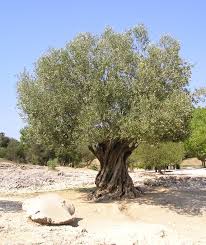
The origin of the olive tree is lost in time, coinciding and mingling with the expansion of the Mediterranean civilisations which for centuries governed the destiny of mankind and left their imprint on Western culture.
Olive leaf fossils have been found in Pliocene deposits at Mongardino in Italy. Fossilised remains have been discovered in strata from the Upper Paleolithic at the Relilai snail hatchery in North Africa, and pieces of wild olive trees and stones have been uncovered in excavations of the Chalcolithic period and the Bronze Age in Spain. The existence of the olive tree therefore dates back to the twelfth millennium BC.
The wild olive tree originated in Asia Minor where it is extremely abundant and grows in thick forests. It appears to have spread from Syria to Greece via Anatolia (De Candolle, 1883) although other hypotheses point to lower Egypt, Nubia, Ethiopia, the Atlas Mountains or certain areas of Europe as its source area. Caruso for that reason believed it to be indigenous to the entire Mediterranean Basin and considers Asia Minor to have been the birthplace of the cultivated olive some six millennia ago. The Assyrians and Babylonians were the only ancient civilisations in the area who were not familiar with the olive tree.
Taking the area that extends from the southern Caucasus to the Iranian plateau and the Mediterranean coasts of Syria and Palestine (Acerbo) to be the original home of the olive tree, its cultivation developed considerably in these last two regions, spreading from there to the island of Cyprus and on towards Anatolia or from the island of Crete towards Egypt.
In the 16th century BC the Phoenicians started disseminating the olive throughout the Greek isles, later introducing it to the Greek mainland between the 14th and 12th centuries BC where its cultivation increased and gained great importance in the 4th century BC when Solon issued decrees regulating olive planting.
From the 6th century BC onwards, the olive spread throughout the Mediterranean countries reaching Tripoli, Tunis and the island of Sicily. From there, it moved to southern Italy. Presto, however, maintained that the olive tree in Italy dates back to three centuries before the fall of Troy (1200 BC). Another Roman annalist (Penestrello) defends the traditional view that the first olive tree was brought to Italy during the reign of Lucius Tarquinius Priscus the Elder (616 - 578 BC), possibly from Tripoli or Gabes (Tunisia). Cultivation moved upwards from south to north, from Calabria to Liguria. When the Romans arrived in North Africa, the Berbers knew how to graft wild olives and had really developed its cultivation throughout the territories they occupied.
The Romans continued the expansion of the olive tree to the countries bordering the Mediterranean, using it as a peaceful weapon in their conquests to settle the people. It was introduced in Marseille around 600 BC and spread from there to the whole of Gaul. The olive tree made its appearance in Sardinia in Roman times, while in Corsica it is said to have been brought by the Genoese after the fall of the Roman Empire.
Olive growing was introduced into Spain during the maritime domination of the Phoenicians (1050 BC) but did not develop to a noteworthy extent until the arrival of Scipio (212 BC) and Roman rule (45 BC). After the third Punic War, olives occupied a large stretch of the Baetica valley and spread towards the central and Mediterranean coastal areas of the Iberian Penisula including Portugal. The Arabs brought their varieties with them to the south of Spain and influenced the spread of cultivation so much that the Spanish words for olive (aceituna), oil (aceite), and wild olive tree (acebuche) and the Portuguese words for olive (azeitona) and for olive oil (azeite), have Arabic roots.
With the discovery of America (1492) olive farming spread beyond its Mediterranean confines. The first olive trees were carried from Seville to the West Indies and later to the American Continent. By 1560 olive groves were being cultivated in Mexico, then later in Peru, California, Chile and Argentina, where one of the plants brought over during the Conquest - the old Arauco olive tree - lives to this day.
In more modern times the olive tree has continued to spread outside the Mediterranean and today is farmed in places as far removed from its origins as southern Africa, Australia, Japan and China. As Duhamel said, "the Mediterranean ends where the olive tree no longer grows", which can be capped by saying that:
"There where the sun permits, the olive tree takes root and gains ground".